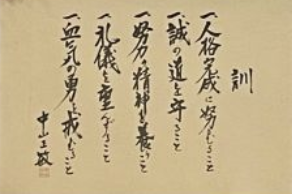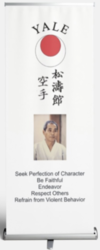“The ultimate aim of the art of karate lies not in victory or defeat, but in the perfection of the character of its participant.” - Gichin Funakoshi, Father of Shotokan Karate
Dojo Kun
With each training at the dojo, we kneel in the seiza position and repeat these five precepts out loud, to reminds us of the right attitude, mind and virtues within the dojo and beyond.
|
|
Jinkaku kansei ni tsutomuru koto
Seek perfection of character
Makoto no michi o mamoru koto
Be faithful
Doryoku no seishin o yashinau koto
Endeavor
Reigi o omonzuru koto
Respect others
Kekki no yuu o imashimuru koto
Refrain from violent behavior
|
What is Do?
“Do” is “the way.” Karate practice allows the participant to develop character and learn to live by following the “Dojo Kun.” It also develops both mental and physical stamina. However, it is very important that the student never gives up, but persists, no matter what the situation may be. Without an earnest effort, without perseverance, the student will never understand the true spirit of Karate.







